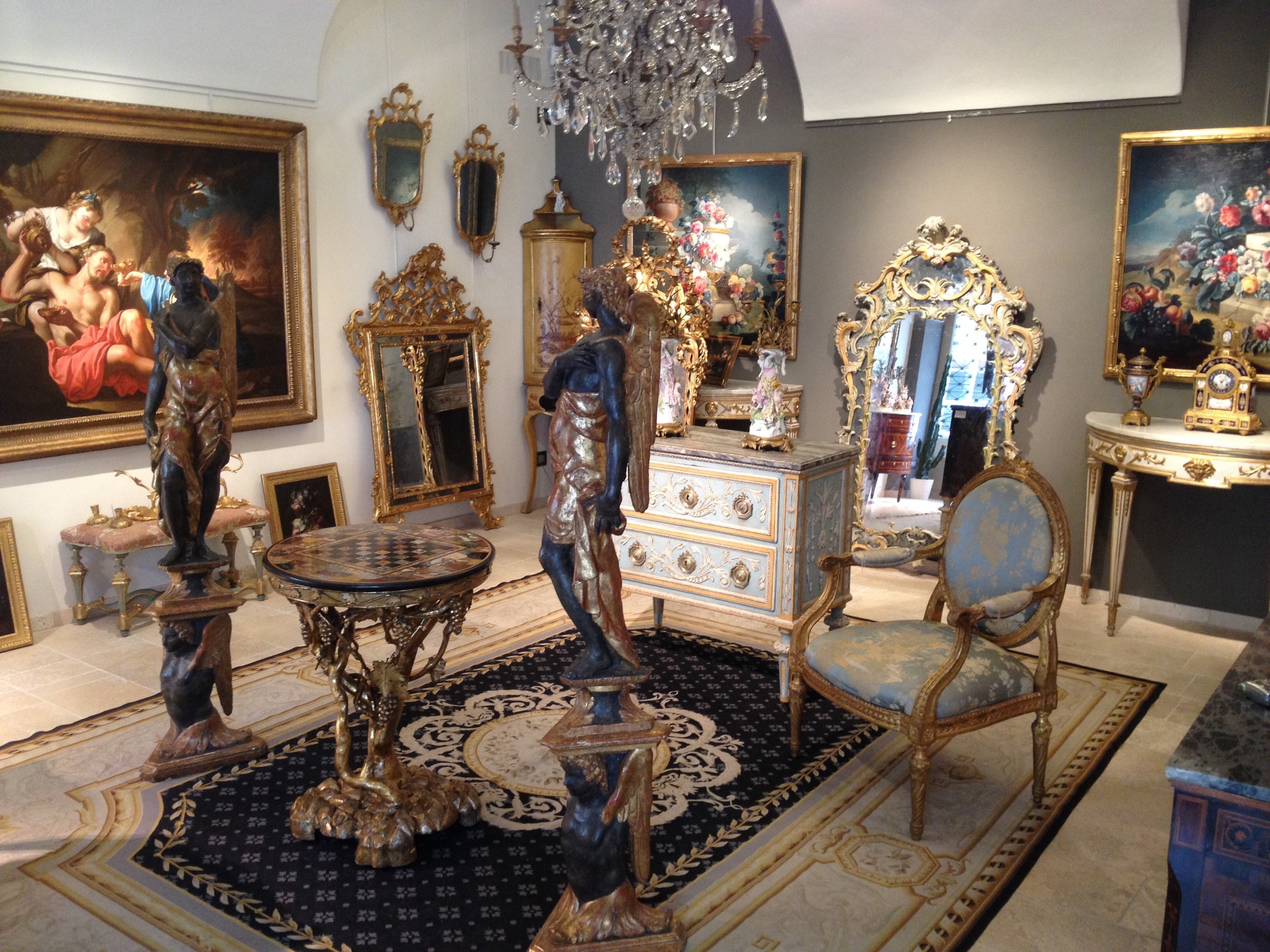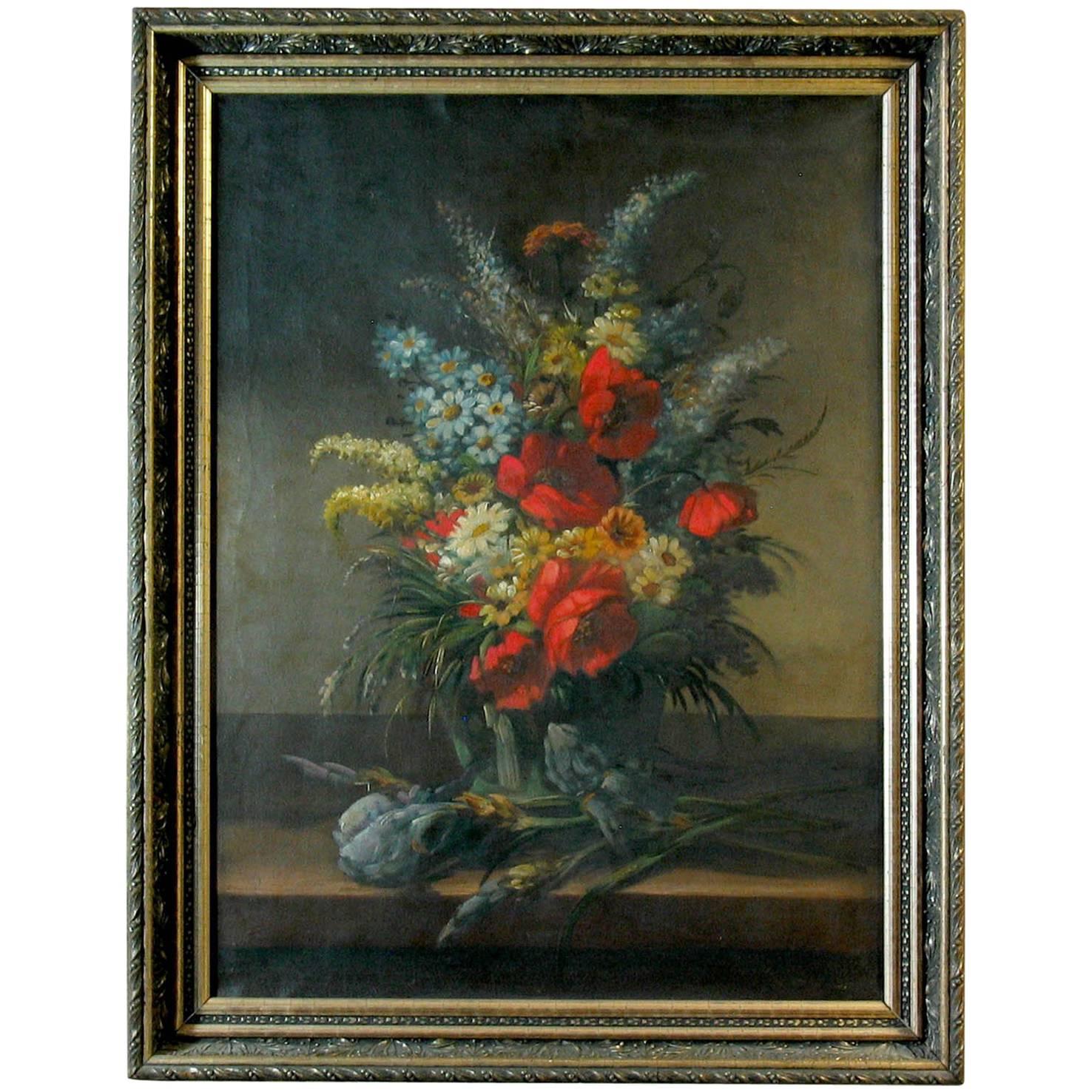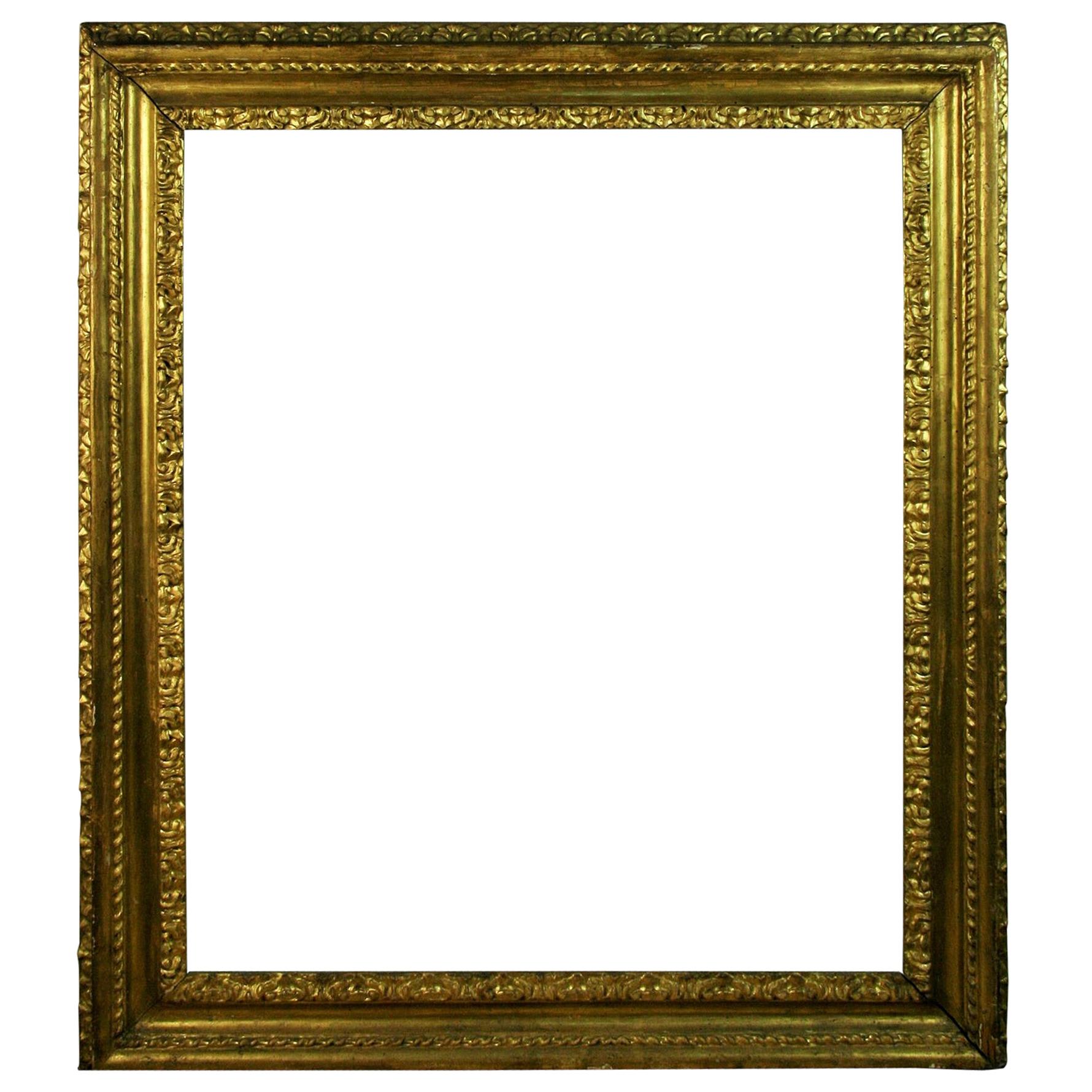Items Similar to 19th Century, Italian Painting with Still Life with Cherubs
Want more images or videos?
Request additional images or videos from the seller
1 of 13
19th Century, Italian Painting with Still Life with Cherubs
About the Item
19th century Roman painter
Still life with cherubs, flower festoons and herma with faun
Measures: Oil on canvas, cm H 78 x W 95 without frame
Cm H 122.00 x W 106 x D 8 with frame.
The work, painted in oil on canvas, octagonal in shape, represents a nature with three putti or cupids playing with flower festoons in a wooded environment in which is placed a herma with faun and, on the left, a large neoclassical marble vase, adorned with buffaloes with festoons and a large floral arrangement. The artist uses a bright color palette in which yellow, red and blue are well balanced with which brightens the flower garlands.
The herma comes from one of the first archaic forms of representation of the dwellings of a divinity that here must be identified with the faun, figure of the Roman mythology, divinity of the nature, the country, the flocks and the woods. He was a powerful and wild god, depicted with goat legs and horns, hirsute legs and hooves, while the bust is human, the bearded face and the expression mischievous. He wandered through the woods, often to chase the nymphs, while playing and dancing. It is one of the oldest Italic deities, derived from the god Pan of Greek mythology. Pan was a non-Olympic deity, with the appearance of a satyr, linked to forests and nature. He was the shepherd god, the god of the countryside and pastures. In some myths he is described as the oldest god of the Olympians: he had drunk with Zeus the milk from Amaltea, raised the dogs of Artemis and taught the divinatory art to Apollo.
The painting dates back to the 19th century, the work of a Roman author.
The canvas is close to similar compositions, with flowers and putti, which were established from the mid-seventeenth century in Rome to find widespread throughout the first half of the eighteenth century, in the Baroque era.
There are numerous authors who proposed this kind of representation, where putti and chubby cupids play and support prosperous garlands and compositions of flowers and fruit. Likewise, the herma with faun, or with other divinities, and mythological figures are often found side by side, around which the cupids joke.
Quite common, as shown by the works proposed here in comparison, is the painting performed with four hands: the putti and figures are made by an artist, while another deals with the representation of flowers and still lifes. One example is that of Mario de ' Fiori, pseudonym of Mario Nuzzi (Penna San Giovanni, 19 January 1603 - Rome, 14 November 1673), who owes his nickname to his famous compositions of flowers, a genre of which he was a great specialist. Mario de' Fiori collaborated with eminent Baroque painters active in Rome, such as Filippo Lauri (Rome 1623 - 1694) or Bernardino Mei (Siena, October 1612 - Rome, 1676). Famous are the four canvases of Palazzo Chigi with the Seasons that see the collaboration of Mario de' Fiori with Lauri, with Mei and with Carlo Maratta (Camerano, 15 May 1625 - Rome, 15 December 1713).
Carlo Maratta (Camerano 1625 - Rome 1713) was a central figure of Roman and Italian painting in the second half of the seventeenth century; during his life he was celebrated as the greatest painter of his time, also marking a large part of the artistic production of the following century. He often collaborated with some important workshops completing their floral arrangements. Among these, in addition to that of the aforementioned Mario Nuzzi, there are those of Giovanni and Niccolò Stanchi and that of Franz Werner von Tamm (1658-1724), a painter active in Rome between 1685 and 1695. Among the best examples are the magnificent mirrors, commissioned by Lorenzo Onofrio between 1660 and 1670 for the Palazzo Colonna, then moved in 1740 in the Great Gallery. Carlo Maratta was responsible for the making of the putti, while Mario de' Fiori and Giovanni Stanchi painted the garlands of flowers. The two painters of still life also made use of the study from life in the realization of the great variety of flowers, taking inspiration from those cultivated in the great garden of the Palace.
As for Niccolò Stanchi (1623/ 1690), the younger brother owner of the workshop after the death of Giovanni, we remember the mirrors in Palazzo Borghese, executed in 1675 in collaboration with Ciro Ferri (1634/ 1689).
In conclusion, the painting in question is to be considered as an example of the vast fortune that this kind of painting had in the seventeenth-eighteenth century and that lasted until the beginning of the nineteenth century, still commissioned by collectors who wanted to decorate their palaces with such kind of paintings from the subjects carefree and graceful.
The work presents canvas and frame, as well as an octagonal frame cassette of great value, baroque. It is possible that the author of the painting used a seventeenth-century canvas adapted to the typically Baroque subject. This could have been done on commission, at a time like the 19th century, when there was a revival of Baroque and Rococo at European level. The painter, as noted, is clearly inspired by the great Seventeenth and Eighteenth century masters of the genre, in particular, for the composition and putti, to Carlo Maratta and Mario de' Fiori and, probably belongs to that category of florists that in Rome knew remarkable fortune in the furnishing of the noble palaces especially after the unity of Italy. A nineteenth-century artist, therefore, but of great quality able to recreate and reinterpret with mastery the great seventeenth-century Roman art; an artist with excellent academic foundations that creates compositions from bright and lively colors and remarkable compositional balance. Unfortunately, the flowers of the Roman nineteenth century have not yet been the subject of careful studies and we hope that they can be soon in order to clarify figures and cultural paths.
We apologize for any errors in translation from Italian.
- Dimensions:Height: 48.04 in (122 cm)Width: 41.74 in (106 cm)Depth: 3.15 in (8 cm)
- Style:Baroque (In the Style Of)
- Materials and Techniques:
- Place of Origin:
- Period:
- Date of Manufacture:19th Century
- Condition:
- Seller Location:IT
- Reference Number:1stDibs: LU4405219686252

About the Seller
5.0
Gold Seller
These expertly vetted sellers are highly rated and consistently exceed customer expectations.
Established in 1980
1stDibs seller since 2019
41 sales on 1stDibs
Typical response time: 1 hour
- ShippingRetrieving quote...Ships From: Italy
- Return PolicyA return for this item may be initiated within 7 days of delivery.
More From This SellerView All
- 18th Century, Italian Still Life with Flowers by Michele Antonio RaposBy Michele Antonio RaposLocated in IT18th century, Italian still life with flowers by Michele Antonio Rapos (Italy 1733-1819) The canvas, of fine workmanship and under good conditions of maintenance, represents a sti...Category
Antique Late 18th Century Italian Baroque Paintings
MaterialsCanvas, Giltwood
- 19Th Century, Pair of French Paintings with Still Lifes in LandscapeBy Jules Alexandre Gamba De PreydourLocated in ITJules Alexandre Gamba De Preydour (1846 - 1931) Pair of paintings depicting still lifes of flowers and fruit with landscape signed lower left and dated 1891 The pair of paintings d...Category
Antique 1890s French Baroque Paintings
MaterialsCanvas
- 17th Century, Oil on Canvas Dutch Painting with Hunting SceneLocated in IT17th century, oil on canvas Dutch painting with hunting scene Oil on canvas. Dimensions: frame W 81 x H 75 cm, canvas 58 x 49 cm The oil on canvas painting depicts a hunting scene in a predominantly rocky landscape. On the right, at the center of the canvas is depicted a group of characters dressed for hunting according to the 17th century fashion of northern Europe. The men stop with their horses and dogs; one of them points downstream, while another one sounds a Horn, used as a call sign in hunting trips. In the foreground on the left another character sits on the ground, turning his back on the observer, in the company of two hunting dogs. The scene takes place in the open air, in a rocky context and the landscape widens towards a valley, beyond which the horizon is lost among mountain reliefs with blue tones. The bright sky is characterized by some clear clouds. The color palette of the canvas is characterized by brown tones; a ray of light that emphasizes the right group, where it stands out illuminated a dog and the spotted steed on which is rising a man with a red mantel...Category
Antique Late 17th Century Dutch Baroque Picture Frames
MaterialsCanvas
- 19th Century, Dance Scene in Ancient Greece signed Johan Raphael SmithBy John Raphael SmithLocated in ITdance scene in Ancient Greece. 19th century, oil on canvas, signed at the bottom left Measures: With frame: L 187 x H 129 x 10.5 cm Without frame: L 155.5 x H 100 The painting, of r...Category
Antique 19th Century English Neoclassical Paintings
MaterialsCanvas
- 17th Century, Italian Painting with Still Life with Fruit, Dogs and CatLocated in IT17th Century, Italian painting with still life with fruit, dogs and cat Measurements: With frame cm W 93 x H 75.5 x D 4; Frame cm W 82.5 x H 66.5 The...Category
Antique 17th Century Italian Baroque Paintings
MaterialsCanvas
- 18th Century, Painting with Still Life by Maximilian PfeilerLocated in ITMaximilian Pfeiler (active Rome, circa 1694-circa 1721 Budapest) Still life with peaches, grapes, figs and pomegranate Oil on canvas, Measures: cm H 63,5 x W 47. With frame cm ...Category
Antique Early 18th Century Italian Baroque Paintings
MaterialsCanvas, Wood
You May Also Like
- 19th Century French School Still Life of Field FlowersLocated in Ottawa, OntarioA brightly colored 19th century French school still life of field flowers Signed J. Levy, lower Left. The painting measures: 25 5/8" inches ...Category
Antique Mid-19th Century French International Style Paintings
MaterialsPaint
- Large Painting Representing "The Adoration Of The Shepherds", Italy 19thLocated in VERSAILLES, FRGrand et beau tableau, huile sur toile, représentant " L'adoration des Bergers " Ce tableau est une œuvre réalisée au début du XIXème siècle par un peintre non identifié mais très talentueux puisqu'il fallait une certaine maitrise pour s'attaquer à la réalisation d'un tel tableau de si grande taille, encadré par un beau cadre en bois sculpté et doré, italien également. Pour comprendre l'origine de ce tableau il faut remonter au début du XVIIème siècle; en effet, une poignée d’artistes, d’Utrecht aux Pays Bas, arrivèrent à Rome appelés par des commanditaires, très impressionnés par le Caravagisme. Parmi eux se trouvait Gerrit van Honthorst...Category
Antique 19th Century Italian Baroque Paintings
MaterialsGiltwood, Paint
- over Sized 19th Century Italian Water Giltwood FrameLocated in Douglas Manor, NY8-154 hand carved Italian water giltwood frame Interior rabbit size 36 x 30".Category
Antique Late 19th Century Italian Paintings
MaterialsGiltwood
- Y. Gianni, Italian the Gulf of Naples, 19th CenturyLocated in Ottawa, OntarioY. Gianni (Italian) The Gulf of Naples, 19th Century. A beautiful signed "Y. Gianni" gouche on paper, framed and matted with description & name on matti...Category
Antique Late 19th Century Italian Grand Tour Paintings
MaterialsPaper
- Painting Oil on canvas Picture of a Navy - 19th Century - FranceLocated in Beuzevillette, FRBeautiful oil on canvas from the 19th century representing a navy. In the foreground, a three-masted ship is moored in the basin, further on we can see other ships and also a quay. V...Category
Antique 19th Century French Paintings
MaterialsCanvas
- Vintage Oversized Watercolor Floral Still Life Painting Artist Signed circa 1950Located in Big Flats, NYAn oversized vintage floral still life painting depicts bouquet of garden flowers (possibly peonies), artist signed lower right, mat...Category
Mid-20th Century American Paintings
MaterialsWood, Paper
Recently Viewed
View AllMore Ways To Browse
Italian Baroque Painting
Wall Cherubs
Cherub Frame
Large Baroque Painting
Italian Baroque Canvas
Italian Baroque Oil Paintings
Blue Cherub
Cherub Face
19th Century Greece Painting
Rococo Cherub
Painting Greek Roman
19th Fruit Still Life
Baroque Oil Painting Large
19th Century Floral Oil Painting
Painted Baroque Mirrors
Large Yellow Mid Century Painting
Wood Cherub Painted
Cherubs Garlands





